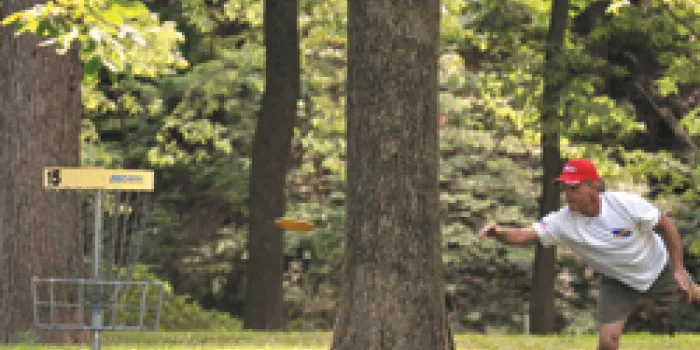Sean Sweeney welcomes any excuse to get outdoors. Perhaps his favorite fresh-air pastime and fitness activity is Frisbee® golf.
The sport, modeled on traditional golf, combines walking and throwing a flying disc at a target. It’s low-impact, making it a fairly good choice for people with bleeding disorders. And because it is most often played in groups, its social element adds to the fun.
Sweeney, who has moderate hemophilia B, has been playing the sport for about five years, since his days as an undergraduate student at the University of Montana in Missoula. “I like it because it gets me outside, and it’s totally relaxed rather than intense,” says Sweeney, 28, of Prince George, British Columbia. “I play to unwind and loosen up my mind a bit.”
“Frisbee golf” is actually a misnomer. The sport, which became popular in the 1970s, is formally known as “disc golf.” Frisbee Disc is the best-known brand of flying discs. Disc golf is played in much the same way as regular golf. Following a designated course, typically consisting of nine or 18 holes, players try to get their disc in each hole in as few throws as possible.
The holes are much larger than those in regular golf. “It would be incredibly challenging to play with golf-ball–sized holes,” says Sweeney with a laugh. Instead, players use a dangling net of chains, set on poles about 5 feet high. If a player hits the net just right, the disc drops into a basket below.
Flexible Sport
As the sport has evolved and drawn a growing number of serious players, the equipment has become increasingly refined. Now players use several types of discs during a game. They tee off using large, heavy discs that can fly far and straight. When they get closer to the hole, players often switch to smaller discs that are more accurate. According to the Professional Disc Golf Association (PDGA), courses can be found in city parks all over the country. The PDGA maintains a directory of existing courses (see “Learn More”). Disc golf can also be a solo pursuit.
“The beauty of it is, people can mark a tree or a bush and say, ‘That’s a hole,’” Sweeney says. The same casual approach applies to discs, he says. While it may be nice to have several to choose from, all you need is one.
How long each game lasts depends on the number of holes, the size of the course and the pace players set for themselves. Sweeney says courses in city parks are often abbreviated, with shorter distances between holes. He estimates such courses might take 30 to 40 minutes. In rural or backcountry areas, the game can last much longer. “In Missoula, the distance between holes was greater, and there were lots of creeks and trees,” Sweeney says. “Games took as long as two hours.”
Moderation Prevents Irritation
“It is a totally noncontact sport, with great exercise from walking and arm motion from throwing the Frisbee,” says Marilyn Passer, PT, of the Mary M. Gooley Hemophilia Center and Rochester General Hospital in New York. “A big plus is that it gets you outside.”
Passer cautions that the sport may present risks for people with target joints. Shoulders or elbows can be sensitive to throwing the disc, while walking can be tough on problem hips, ankles and knees. “Start with moderation,” Passer advises. “Throw a Frisbee a few times in the yard to see if it causes any irritation. You will know right away if it doesn’t feel right.”
Because players take a walking break between each throw, there’s no real worry of repetitive-motion injuries, such as tendonitis, Passer says. Still, she recommends stretching before a game. She also advises her patients to talk to a physical therapist about injury prevention, exercise and stretching instruction prior to starting any new sport.
The Ups and Downs of Ultimate
Another popular disc sport is called “Ultimate” (formally “Ultimate Frisbee”). Much more fast-paced and intense than disc golf, Ultimate pits two teams of seven players against each other in a match that combines elements of soccer and football. Teams score by catching a disc in the opposing team’s end zone. Getting the disc there requires teamwork, passing skills and endurance.
There are several types of Ultimate, depending on where the game is played. Traditional Ultimate is played outdoors in an area about the size of a soccer field. But it can just as easily be an indoor sport. Because the indoor field is generally smaller than the outdoor one, the teams field fewer players, usually four or five at a time. Another popular variant is Beach Ultimate, played on the sand between two teams of four or five players.
Unlike Frisbee golf, Ultimate is a limited contact sport. Passer says Ultimate is too risky to recommend to her patients, unless they are in very good shape with no target joints. The National Hemophilia Foundation’s guide to sports, Playing It Safe, rates Ultimate as moderately risky; disc golf is rated safe to moderate.
“Someone with a mild disorder could likely tolerate the running and the contact,” Passer says. “But I would be concerned about anyone with a target joint, especially ankles, knees and hips.” Because of its high intensity, Passer strongly advises talking to a physical therapist before giving Ultimate a try.
So, as the weather warms up and you’re itching to get outside, consider grabbing a few friends and making your own disc golf course.

